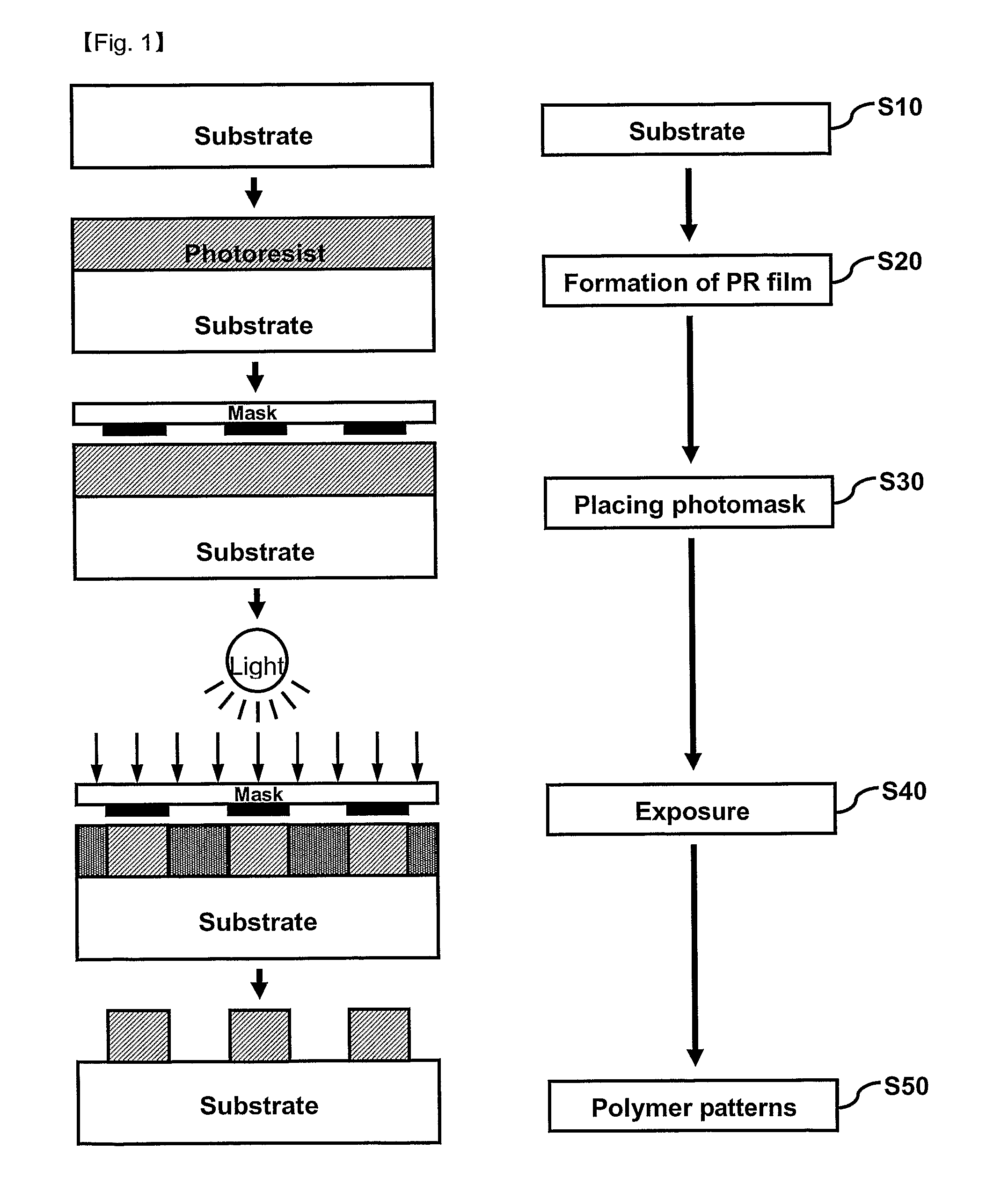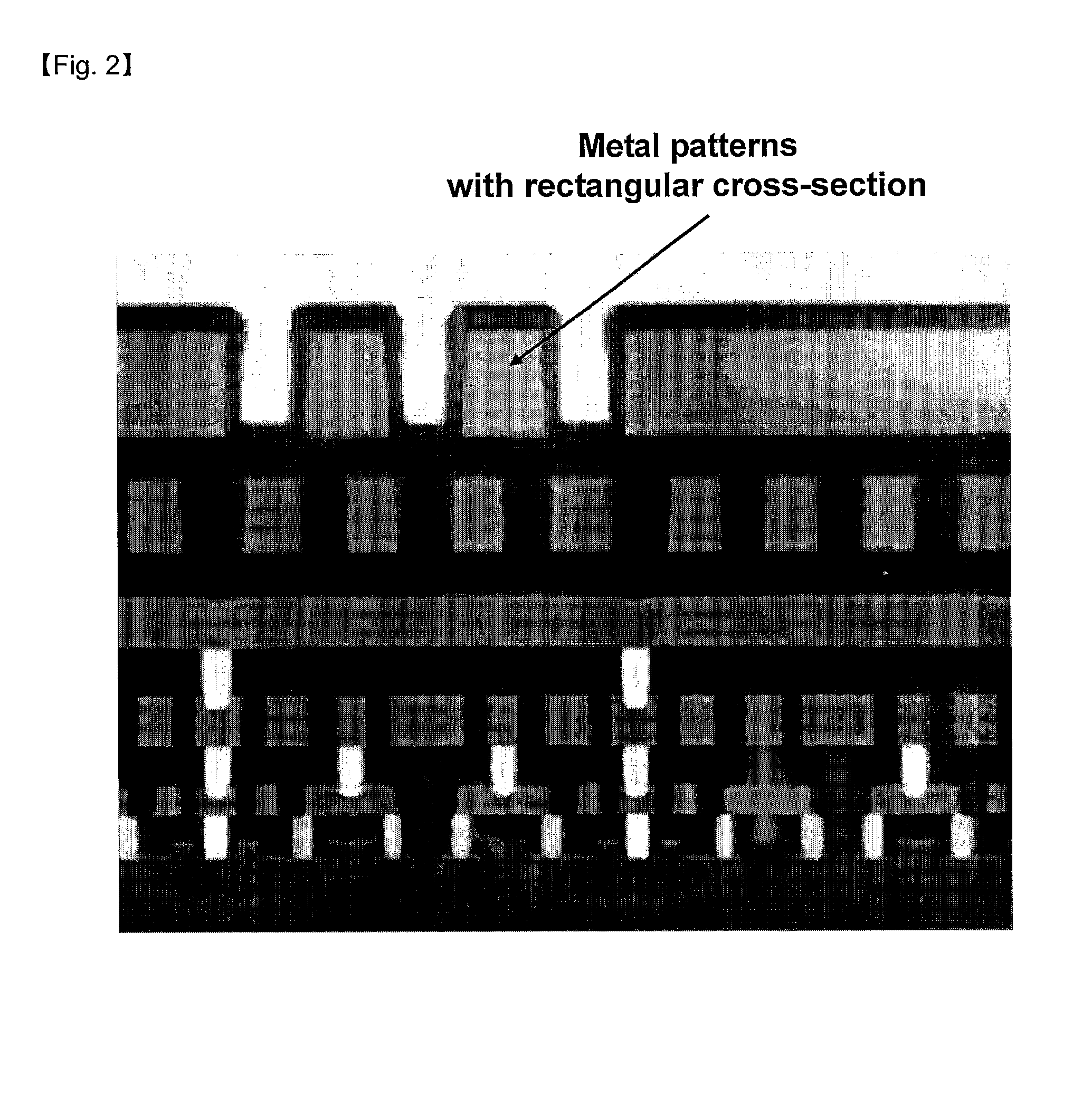Polymer pattern and metal film pattern, metal pattern, plastic mold using thereof, and method of the forming the same
a technology of metal film and polymer, applied in the field of polymer patterns, can solve the problems of many problems in cost and process stability, reducing the yield and uniformity of products, and unable to meet the diverse demands of three-dimensional structures, etc., and achieves the effects of high reliability, easy preparation, and improved cost competitiveness and easiness of processes
- Summary
- Abstract
- Description
- Claims
- Application Information
AI Technical Summary
Benefits of technology
Problems solved by technology
Method used
Image
Examples
embodiment 1
[0075]FIG. 3a is a perspective view of first polymer patterns formed according to the inventive lithography process, FIG. 3b is a cross-sectional view of the first polymer patterns formed according to the inventive lithography process, and FIG. 3c is a secondary electron microscopic photograph taken for a portion of the cross-section of the first polymer patterns.
[0076]Referring to FIGS. 3a to 3c, the first polymer patterns have the patterns 101a which are concave from the surface of the polymer film 101 deposited on the substrate 100 in a direction perpendicular to the substrate 100 and extend in a direction parallel to the substrate 100. The vertical cross-section of the concave patterns has at least one curved surface.
[0077]Namely, as shown in the drawings, the concave patterns 101a are so formed that they have a circular or oval shape, the top of which is cut in a straight line. These circular or oval patterns can vary in their shape or depth depending on the amount of UV applie...
embodiment 2
[0098]FIGS. 9a and 9b show the structure of first metal film patterns of a given shape according to the present invention, FIGS. 9c and 9d show the structure of second metal film patterns of a given shape according to the present invention, and FIGS. 9e and 9f show the structure of third metal film patterns of a given shape according to the present invention.
[0099]For reference, like reference numerals denote like elements throughout the drawings.
[0100]Referring to FIGS. 9a and 9b, the first metal film patterns 205 have pattern 205a which are concave in a direction perpendicular to the substrate 200 and extend in a direction parallel to the substrate 200. The vertical cross-section of the concave pattern 205a is open at its top and has at least one curved surface.
[0101]Depending on the formation position of the patterns, the first metal film patterns 205 are so formed that they are away from the substrate 200 so as to be suspended in space or are in contact with the substrate 200.
[0...
embodiment 3
[0121]FIGS. 12a and 12b show the structure of first metal patterns having a given shape according to the present invention, and FIGS. 12c and 12d show the structure of second metal patterns having a given shape according to the present invention.
[0122]As shown in FIGS. 12a and 12b, the first metal patterns 310 have concave patterns formed on the substrate 300 in a direction perpendicular to the substrate 300 and extending in a direction parallel to the substrate 300. The vertical cross-section of the concave patterns has at least one curved surface.
[0123]Namely, the concave patterns shown in FIGS. 12a and 12b have a rod shape with a circular or oval cross-section, the top of which is cut in a straight line. These circular or oval patterns can vary in their shape or depth depending on the amount of UV irradiated during the lithography process.
[0124]Depending on the formation position of the metal patterns, the first metal patterns 310 are away from the substrate 300 so as to be suspe...
PUM
| Property | Measurement | Unit |
|---|---|---|
| angle | aaaaa | aaaaa |
| shape | aaaaa | aaaaa |
| density | aaaaa | aaaaa |
Abstract
Description
Claims
Application Information
 Login to View More
Login to View More - R&D
- Intellectual Property
- Life Sciences
- Materials
- Tech Scout
- Unparalleled Data Quality
- Higher Quality Content
- 60% Fewer Hallucinations
Browse by: Latest US Patents, China's latest patents, Technical Efficacy Thesaurus, Application Domain, Technology Topic, Popular Technical Reports.
© 2025 PatSnap. All rights reserved.Legal|Privacy policy|Modern Slavery Act Transparency Statement|Sitemap|About US| Contact US: help@patsnap.com



